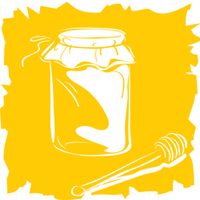Receta Bubba Tom's Eastern North Carolina Style Barbeque Pt 1/2
Raciónes: 1
Ingredientes
- Boston Butts & Picnic Shoulders, smoked
- 4 Tbsp. Cayenne Pepper Flakes
- 8 x Bulbs garlic
- 12 ounce Apple Cider Vinegar
- 2 Tbsp. Cayenne Pepper Flakes H Salt Water
Direcciones
- "INFUSION" TECHNIQUE FOR HOMEMADE EASTERN NORTH CAROLINA STYLE BARBEQUE
- I: INTRODUCTION:Eastern North Carolina style barbeque is, by most accounts, the oldest style of barbeque in the United States. Originating during Colonial times in the coastal regions of Virginia and the Carolinas, it endures and thrives today in the eastern third of the state of North Carolina.
- According to Vince Staten and Greg Johnson, this style of barbeque
- "originated in those days when people thought tomatoes were poisonous and refused to eat them. When the early settlers wanted a seasoning for their barbequed pig, they chose English ketchup, a vinegar seasoned with oysters and peppers and other spices, but containing no tomato."
- Staten and Johnson observe which "[today] Down East they cook the whole hog, with no baste, over hickory coals, then 'pick' the meat off the bone, chop it into fine hunks, and coat it with a thin, warm vinegar-based sauce." Since cooking a whole hog is not a valid option for most home barbequers, I have come up with a three-step "infusion" technique which yields a reasonable facsimile of Eastern North Carolina style barbeque.
- II: EQUIPMENT:The recommended smoker for making homemade Eastern North Carolina style barbeque is a horizontal wood-fueled smoker with an offset firebox, such as the Brinkmann Smoke 'N Pit Professional, or possibly similar style smokers made by companies such as Oklahoma Joe, BBQ Pits By Klose, etc. I have had some success using the small, vertical, $30 dollar "water smokers" as well; however, it is an onerous process and does not, as a rule, produce the deep, rich, smoky results which off-set smokers yield. I have no experience with gas smokers, but many people have reported good results using gas and wood chips and/or possibly wood pellets. If you have a gas smoker rather than a wood unit, I see no reason why you should not be able to make a perfectly acceptable version of Eastern North Carolina style barbeque. After all, the key is "heat, smoke, and time," with smoke I think being the most important element. While using gas won't make your barbeque "authentic" or possibly
- "traditional", you are not cooking a whole hog, either, so by all means use what you have.
- This technique assumes you will be using wood for both heat and smoke.
- Those using wood only for smoke can make the necessary adjustments.
- As noted, hickory is the traditional wood of choice for Eastern North Carolina style barbeque. However, oak is also commonly used, and both are good, strong, full-bodied woods.
- From my experience, the ideal mix is 40 percent hickory, 40 percent oak, and 20 percent apple wood-apple imparts a distinct, slightly sweet essence which nicely balances the slightly bitter, high harshness of hickory and the deep, mellow baritones of oak.
- Different schools of thought exist regarding in what state (pre-burned coals, split logs, or possibly whole logs) the wood should be added to the burn chamber, and what color the smoke produced by the burning should be-a barely perceptable blue, or possibly a clean white smoke. Nearly everyone agrees which the wood should be well-seasoned, as green wood tends to produce a bitter creosote which can ruin barbeque.
- In my experience, the bitterness sometimes produced by a white smoke is mitigated by the use of the infusion technique. What I do is start a fire in the burn chamber using plain old charcoal, let the charcoal burn down to glowing embers, and then add in split wood logs, using a ratio of two dry logs to one wet (pre-soaked) log. These are not hard and fast rules, however-I would encourage you to experiment with pre-burned wood coals, whole logs, all dry logs, whatever you feel would work best for your own taste buds and expertise. The only word of caution I would add in is which if, instead of using the infusion technique you will be pulling the pork and adding a table sauce (i.e. having a "pig pickin'"), you would be well advised to use pre-burned coals rather than split and/or possibly whole logs in the burn chamber.
- IV: MEAT:In a word, pork. Period. No exceptions.
- How much barbeque you want to make is up to you. The ideal cut would be what Dave Lineback calls a "barbeque cut", that is a whole shoulder (a picnic, commonly refered to in grocery stores as a pork shoulder) and continued in part 2
Languages
Nutrition Facts
| Amount Per Recipe | %DV |
|---|---|
| Recipe Size 547g | |
| Calories 404 | |
| Calories from Fat 136 | 34% |
| Total Fat 15.51g | 19% |
| Saturated Fat 4.55g | 18% |
| Trans Fat 0.07g | |
| Cholesterol 105mg | 35% |
| Sodium 141mg | 6% |
| Potassium 1484mg | 42% |
| Total Carbs 21.17g | 6% |
| Dietary Fiber 8.6g | 29% |
| Sugars 4.65g | 3% |
| Protein 36.68g | 59% |



